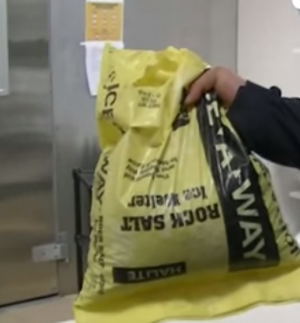Rock Salt is the most commonly used method for melting that pesky winter ice that builds up on our roads, driveways, and front stoops. It’s cheap n’ easy to apply and frankly it does a darn good job, but before you go out and douse your driveway to keep Santa from taking a nasty spill this year, there’s a few things you should know. Rock salt is a very corrosive and concentrated substance, which can cause problems for your local plants, animals, and waterways. Not to mention it can do pretty serious number on your paintjob.
What’s that you say? It’s just salt which exist in nature anyways, so what’s the big deal?? well….you’re right. Rock salt is essentially just large chunks of sodium chloride minerals, the same stuff you used to salt those holiday cookies, but the danger comes in the amount not from the chemical makeup. In nature it’s all over the place. It’s in the soil, the air, the ocean, heck humans are made of about 1% salt, but it always subscribes to a natural balance. When you dump a large input of salt into a system that is not equipped to deal with it, it can upset the balance and cause real problems for plants and animals.
So here’s where it becomes your problem. Salt is water soluble, meaning that it dissolves into water and becomes a component of the fluid. It then can flow with the water wherever it is headed and ends up wherever the topography flattens out. When you use it to melt ice in your driveway it does just that, and flows off of your impermeable driveway until it gets absorbed or pools somewhere flat. Now this is troublesome because most often driveways are designed on a down slope to allow excess water to runoff of them. This means that the salty water will either runoff onto your lawn, or into the street where it will continue flowing into a storm drain, culvert, or water feature.
If it ends up in your lawn, its pretty much game over for your grass. The salty water is absorbed into the soil which lowers the PH making the soil more acidic, which inhibits nutrient and water transfer to the plants that grow there. It’s just like if you eat too much salty popcorn and have to drink more fluids to balance yourself out. When excess salt is present plants need more water to compensate which they may not be able to get. Additionally, the animals that depend on eating your lawn to survive also get the short end of the stick. They are left either with no food, or the food they do get is very high in salt which can cause health problems, namely salt poisoning. Salt is also an irritant, especially in high concentrations, which means pets and wildlife with pads on the bottoms may get superficial burns.
So now lets say that your property is safe from salt damage and you’re one of those households whose excess water drains directly into the street, you’re off the hook right? Sorry, no such luck. When salient water flows onto an impermeable surface like the street it just keeps on trucking until it either gets absorbed and ruins some other poor saps lawn, or it makes its way into some sort of storm water drainage infrastructure, be it a drain, culvert, drainage ditch, river, stream or something of the like. Now as we know many of these outlets feed directly into freshwater systems like the local river or stream in an effort to prevent flooding and dilute pollution inputs. The funny thing about salt and freshwater is that a very small concentration of sodium chloride can have an un-proportionally large effect on water quality. It only takes a pinch, no pun intended, to degrade water past the point where it is no longer safe for consumption. So when you get a whole community salting their driveways and the runoff is coagulating in the same drainage systems it can really cause some serious damage. So come springtime when everything starts flowing again, plants and wildlife that use streams as drinking and food sources are heavily impacted.
So now you’re probably thinking, “great now I feel bad, but I still don’t have a solution to my ice problem”… Well have no fear; there are a number of environmentally friendly ice melters that will do the trick. As this issue has gained more notoriety in recent years, people have developed all sorts of new commercial solutions to take care of the problem without angering the local Raccoon population. Here at the Wildlife Center we came up with our own home-brew to melt ice using things we found in our freezer, and it works pretty well if I do say so myself. Check out the video link for our recipe, and have a good winter.


